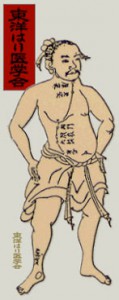What is Toyohari?
Toyohari is a style of Japanese Acupuncture.
What is the difference with other styles of Acupuncture?
From the period it originated in China, different styles of Acupuncture have evolved and developed. In the West the most common and widely practised is a style called TCM (Traditional Chinese Medicine). Though based on similar fundamental principles, Toyohari is quite different in a few important ways; ways which sometimes make Toyohari especially acceptable to those unfamiliar with or wary of acupuncture. In general finer needles are used and these are inserted less deep and many of the specialised needle techniques are even non-insertive. The ability to carry out treatment using these subtle techniques is specifically characteristic to Toyohari. Another characteristic is the strong emphasis on palpation which was developed in Japan by blind practitioners. Visually-impaired practitioners have played a major part in the development of acupuncture in Japan in the last few hundred years. For this reason the sense of touch and extremely delicate techniques have become a characteristic of Japanese approaches.
What can I expect during a Toyohari treatment?
The diagnosis involves asking about the main symptoms, your past and present medical history and additional information that might be relevant. The next step is diagnosis through palpation on the treatment table. The practitioner palpates the meridians, the abdomen and performs pulse diagnosis at the wrist. On account of the subtle and gentle techniques mentioned earlier, the treatment that follows is a relaxing experience and virtually painless. A sensation of warmth and tingling may be experienced, however, as the chosen points are stimulated. Additional techniques like moxibustion (warming a special herb on selected acupoints) and cupping might be used.
Who can be treated with Toyohari?
Using the appropriate dosage of treatment and utilizing some of the specialized non-insertive tools and techniques makes this style suitable for all ages – for adults, the elderly, children and even for babies.
Is it safe?
All registered Toyohari practitioners are already trained in acupuncture both to undergraduate and more advanced levels and are experienced practitioners. Widespread research has demonstrated that in fact all acupuncture, when carried out by appropriately trained practitioners, is an extremely safe form of therapy.
What type of health complaints can be treated?
The range of conditions that can be treated with Toyohari is wide. It includes: anxiety and stress, arthritis, asthma, back pain, circulatory problems, depression, digestive disorders, dizziness, ear nose and throat problems, facial paralysis, fatigue and low energy, gynaecological problems, headaches, high blood pressure, immune related problems, infertility, irritable bowel, menstrual irregularities, migraines, musculo-skeletal problems, painful conditions, palpitations, pregnancy related conditions, respiratory problems, sciatica, sports injuries and urinary problems. This list is by no means exhaustive.
How many treatments will I need and what is the frequency of treatment?
The amount of treatments depends on the type of condition. Acute conditions may need only 3 to 5 treatments while chronic conditions may need more treatments.Treatment is usually weekly to begin with, though for very acute conditions, it may be helpful to come more than once a week. When the condition improves, frequency of treatment can be reduced.
Do you have to believe in Toyohari in order for it to work?
No, you should not have to believe in any therapy for it to work. But trusting your practitioner and having a positive attitude towards your own healing can definitely be beneficial regardless of the medicine or therapy used.
Who are Toyohari practitioners?
The study of Toyohari is done at a post-graduate level. This means that your practitioner has already qualified as an acupuncturist before training in Toyohari. To attain certification in Toyohari, the practitioner must complete a comprehensive one year’s minimum training programme organized through the EBTA. Additionally in order to maintain a registered membership of the EBTA, practitioners are committed to attending regular study groups and international seminars in both Europe and Japan.

